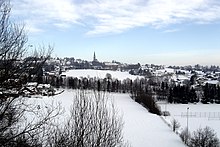Tittlingen granite
Tittling granite , categorized as Tittling granodiorite , occurs in the largest granite deposit in the eastern Bavarian Forest near Fürstenstein / Tittling . This occurrence in the intrusive area of Lower Bavaria originated in the Upper Carboniferous ; it is about 320 million years old.
Geology and occurrence
In the Bavarian Forest there are multiple occurrences of granite, the largest is that of the prince and Steiner Tittlinger space. It has an area of 160 km². This massif stretches in a teardrop shape in north-south direction for around 17 kilometers and in east-west direction for twelve kilometers on the surface. It is part of the Bohemian Massif , which has an extension of 300 × 300 kilometers. The rock complex also consists of diorites , such as the Fürstensteiner diorite , with an age of more than 330 million years. While the Saldenburg granite covers half of the area, the Tittling granite is the most commonly used rock in the complex there.
historical overview
This granite has been quarried and used around Tittling for centuries. In addition to the Tittlingen granite, the Hauzenberg granite is of great cultural and historical importance. The mining areas of both hard rocks are not far from each other and the granite industry companies had factories and quarries in both Tittling and Hauzenberg. Furthermore, economic and political changes had similar effects in both mining areas, such as unemployment and economic decline in both world wars and sales crises since the 1980s, when cheap imports from India and China drove granites from the Bavarian region out of the market. Recently, the competitive conditions for the sale of domestic rocks have improved again because the international freight costs have risen considerably.
Quarries and rock description
Quarries have local names such as Höhenberg-Steinbruch near Tittling, Buchet-Steinbruch near Fürstenstein and Hötzendorf-Bruch near Tittling.
Tittling granite is medium-grained and speckled in black and white. It contains 44 percent quartz , 33 percent plagioclase , nine percent alkali feldspar , eight percent biotite , four percent muscovite , one percent chlorite and less than one percent accessories . This granodiorite has an average grain size of one and a half millimeters.
use
The Tittlingen granite is weather-resistant, polishable and stable against chemical aggressions.
Granodiorites differ from granites in that they have a higher mineral content of plagioclase than of potassium fields and they are never colored. With regard to their technical properties, granodiorites hardly differ from granites.
In the granite quarries in Tittlingen, stone for buildings and bridges was produced around 1900 and delivered to Bavaria, Württemberg, Hesse, Prussia and Hamburg. Paving material went to Hungary, Bavaria and Württemberg.
The Tittlinger granite was used, among other things, at the state fire brigade school in Regensburg, the local health insurance fund in Freyung , the churches in Grainet and Tittling, at the main underground station in Munich and as curbs. Franz Beckenbauer presented a water basin made of Tittlingen granite, in which an eleven-ton Impala soccer ball spins on a film of water, to the public on the occasion of the 2006 World Cup in Munich. The so-called World Cup fountain is set up in front of the north entrance of the New Munich Trade Fair Center .
See also
Web links
- Granite for art. The Höhenberger Bruch near Tittling (PDF file; 217 kB)
Individual evidence
- ↑ Gerhard Lehrberger: Granite - The highest and the lowest. In: Winfried Helm (Ed.): Granit. Tute Druck, Salzweg 2007, ISBN 978-3-00-023087-5 , p. 42 f.
- ↑ Stonereport: Stone Cluster eastern Bavaria. Out of the crisis ( page no longer available , search in web archives ) Info: The link was automatically marked as defective. Please check the link according to the instructions and then remove this notice.
- ↑ a b Wolf-Dieter Grimm: Pictorial atlas of important memorial stones of the Federal Republic of Germany. Edited by the Bavarian State Office for Monument Preservation, Rock No. 016, Lipp-Verlag, Munich 1990, ISBN 3-87490-535-7 .
- ↑ Paul Praxl : The main source of food in this area. The history of the granite industry in Eastern Bavaria. In: Winfried Helm (Ed.): Granit. P. 180.
- ↑ Information on www.niederbayern.de ( page no longer available , search in web archives ) Info: The link was automatically marked as defective. Please check the link according to the instructions and then remove this notice.
Coordinates: 48 ° 43 '32.9 " N , 13 ° 21' 38.1" E

